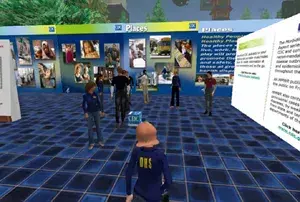 (June 2007) If you’re an urban planner, you may learn how a proposed road could affect gridlock by “building” a city in Sim City. If you’re an environmental engineer, you might explore “eco what-ifs” in Sim World. But if you’re a DHS emergency-response planner … you’re stuck in Real World 101.
(June 2007) If you’re an urban planner, you may learn how a proposed road could affect gridlock by “building” a city in Sim City. If you’re an environmental engineer, you might explore “eco what-ifs” in Sim World. But if you’re a DHS emergency-response planner … you’re stuck in Real World 101.
Or are you? What if a 3-D “virtual” world could help emergency-response experts plan, control, and (just maybe) carry out a response to a real-world emergency? For months, this question had been bouncing around the halls of the S&T Directorate’s Office for Interoperability and Compatibility (OIC), which is part of the Command, Control, and Interoperability Division. OICers could dream it, but could they do it?
On June 8, a half-dozen OICers took the first step to find out … by teleporting into Linden Lab’s Second Life, a 3-D graphical world that, like the Matrix, blurs the line between real life and virtual life.
No one, of course, actually teleported; instead, participants moused, keystroked, and used their touchpads to make their personal “avatars” walk, fly, schmooze, and explore “islands” owned by the National Oceanic and Atmospheric Administration (NOAA), the U.S. Centers for Disease Control and Prevention, and other agencies.
“We’re just getting our feet wet,” says Tony Frater, the Division’s Research Director of Communication, Interoperability, and Compatibility. Once in NOAA’s virtual world, Frater and his teammates--chosen, he explained to them, “because you were techy enough”--island-hopped to see how other agencies are using Second Life to reach out to citizens, conduct day-to-day e-government, team up, and plan emergency response. Leaving their Blackberries behind, the intrepid explorers “landed” in Meteora, a NOAA island built to simulate a city that has been destroyed by a tsunami.
Think of Second Life as The Sims 2--a global Sims running on the Web--but with real-world consequences. OIC stakeholders can mingle with one another and swap knowledge with information systems--for example, with maps of weather, buildings, and airborne pathogens.
The gathering was the first of several designed to let OIC stakeholders get their feet wet in virtual conferencing. Later, OIC will test how practically a far-flung community of emergency-response thinkers can meet up in the virtual world to collaborate during an emergency. Will OIC, like NOAA, one day have its own island? “We’re definitely thinking of that as our next step,” says Frater.
To request more information about this story, please e-mail st.snapshots@hq.dhs.gov.
